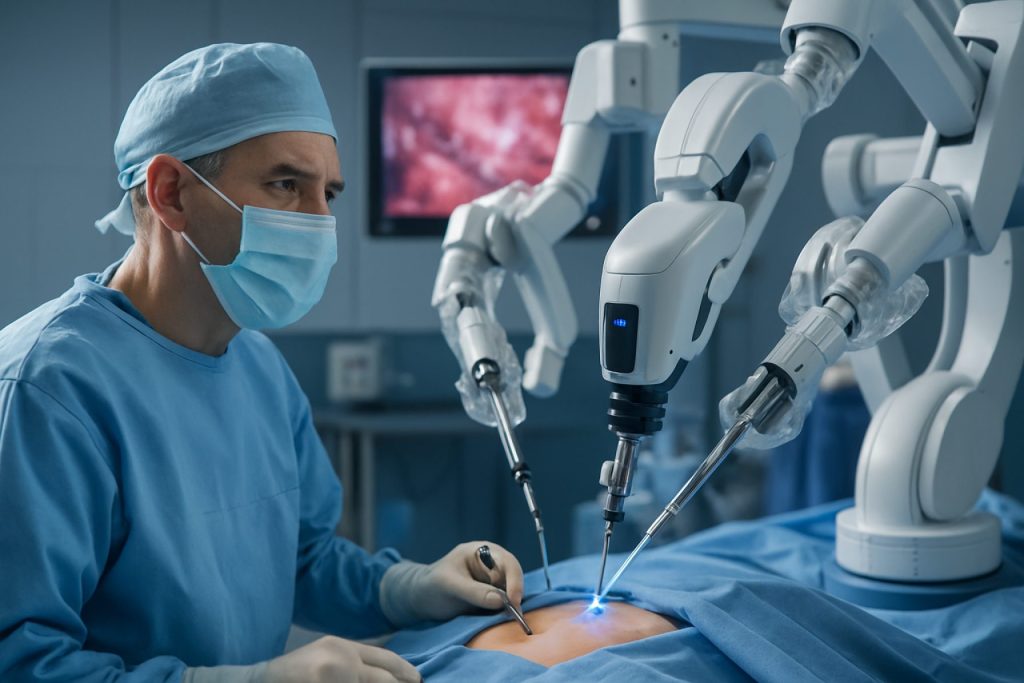
Augmented Surgical Robotics Industry Report 2025: Market Growth, AI Integration, and Strategic Opportunities Unveiled. Explore Key Trends, Forecasts, and Competitive Insights Shaping the Next Five Years.
- Executive Summary & Market Overview
- Key Technology Trends in Augmented Surgical Robotics
- Competitive Landscape and Leading Players
- Market Growth Forecasts (2025–2030): CAGR, Revenue, and Volume Analysis
- Regional Market Analysis: North America, Europe, Asia-Pacific, and Rest of World
- Future Outlook: Emerging Applications and Investment Hotspots
- Challenges, Risks, and Strategic Opportunities
- Sources & References
Executive Summary & Market Overview
Augmented surgical robotics represents a transformative convergence of advanced robotics, artificial intelligence (AI), and augmented reality (AR) technologies, designed to enhance the precision, efficiency, and outcomes of surgical procedures. By 2025, the global market for augmented surgical robotics is poised for significant expansion, driven by increasing demand for minimally invasive surgeries, technological advancements, and a growing emphasis on patient safety and recovery outcomes.
According to recent market analyses, the global surgical robotics market is projected to surpass $15 billion by 2025, with augmented capabilities—such as real-time imaging, haptic feedback, and AI-driven decision support—emerging as key differentiators in next-generation systems. North America currently leads adoption, fueled by robust healthcare infrastructure and high investment in medical innovation, while Asia-Pacific is expected to witness the fastest growth due to rising healthcare expenditures and expanding access to advanced surgical care Fortune Business Insights.
Major industry players, including Intuitive Surgical, Medtronic, and Smith+Nephew, are investing heavily in R&D to integrate AR overlays, machine learning algorithms, and enhanced robotic dexterity into their platforms. These innovations enable surgeons to visualize anatomical structures in 3D, receive intraoperative guidance, and perform complex procedures with greater accuracy and control. The integration of cloud-based analytics and tele-mentoring further expands the reach and scalability of these systems, supporting remote collaboration and training MarketsandMarkets.
- Key Drivers: Rising prevalence of chronic diseases, aging populations, and the need to reduce surgical complications and hospital stays.
- Challenges: High capital costs, regulatory hurdles, and the need for specialized training among surgical teams.
- Opportunities: Expansion into emerging markets, development of cost-effective robotic platforms, and integration with digital health ecosystems.
In summary, the augmented surgical robotics market in 2025 is characterized by rapid technological evolution, increasing clinical adoption, and a competitive landscape shaped by both established leaders and innovative startups. The sector’s trajectory suggests continued growth, with augmented capabilities setting new standards for surgical care worldwide.
Key Technology Trends in Augmented Surgical Robotics
Augmented surgical robotics is rapidly transforming the landscape of minimally invasive and complex surgical procedures. In 2025, several key technology trends are shaping the evolution and adoption of these systems, driven by advances in artificial intelligence (AI), machine learning, enhanced visualization, and connectivity.
- AI-Driven Decision Support: The integration of AI and machine learning algorithms into surgical robots is enabling real-time data analysis and intraoperative guidance. These systems can now process vast amounts of patient data, imaging, and procedural information to assist surgeons in making more informed decisions, reducing errors, and improving outcomes. For example, AI-powered platforms are being developed to provide predictive analytics for surgical planning and to adapt intraoperative strategies based on real-time feedback (Intuitive).
- Enhanced Visualization and Augmented Reality (AR): Augmented reality overlays and 3D visualization tools are becoming standard features in next-generation surgical robots. These technologies allow surgeons to visualize anatomical structures with unprecedented clarity, superimposing critical information directly onto the surgical field. This trend is particularly evident in neurosurgery and orthopedic procedures, where precision is paramount (Medtronic).
- Remote and Telesurgery Capabilities: Advances in 5G connectivity and low-latency communication are enabling remote surgical interventions and tele-mentoring. Surgeons can now operate robotic systems from distant locations, expanding access to specialized care and expertise, especially in underserved regions. This trend is supported by ongoing pilot programs and regulatory advancements in telemedicine (Smith+Nephew).
- Miniaturization and Modular Design: The push towards smaller, more flexible robotic instruments is making it possible to perform surgeries in anatomically challenging areas with minimal invasiveness. Modular robotic platforms allow for customization based on specific procedural needs, improving versatility and cost-effectiveness for healthcare providers (Johnson & Johnson MedTech).
- Data Integration and Interoperability: Seamless integration with hospital information systems, electronic health records, and imaging platforms is becoming a priority. This interoperability ensures that surgical robots can access and utilize comprehensive patient data, supporting personalized and data-driven surgical care (Siemens Healthineers).
These technology trends are collectively driving the augmented surgical robotics market toward greater precision, efficiency, and accessibility, setting the stage for continued innovation and broader clinical adoption in 2025 and beyond.
Competitive Landscape and Leading Players
The competitive landscape of the augmented surgical robotics market in 2025 is characterized by rapid innovation, strategic partnerships, and a growing number of entrants seeking to capitalize on the convergence of robotics, artificial intelligence (AI), and augmented reality (AR) in surgical settings. The market is dominated by a few established players, but the influx of startups and technology companies is intensifying competition and accelerating the pace of technological advancement.
Leading Players
- Intuitive Surgical remains the market leader, leveraging its da Vinci platform and expanding its capabilities with AR overlays and AI-driven analytics to enhance surgical precision and workflow efficiency.
- Medtronic has made significant strides with its Hugo™ robotic-assisted surgery system, integrating advanced visualization and data analytics to compete directly with Intuitive Surgical in both established and emerging markets.
- Smith+Nephew is gaining traction with its CORI Surgical System, which combines robotics and AR for orthopedic procedures, emphasizing personalized surgery and improved patient outcomes.
- Stryker continues to expand its Mako SmartRobotics™ platform, integrating AR-based planning and intraoperative guidance, particularly in joint replacement surgeries.
- Johnson & Johnson (Ethicon) is advancing its Ottava robotic system, focusing on modularity and digital integration, with anticipated launches and clinical trials in 2025.
Beyond these established firms, a wave of innovative startups and technology companies—such as Vesalius Technologies and Augmenta Surgical—are introducing AR-driven navigation, real-time tissue recognition, and cloud-based surgical collaboration tools. These entrants are often more agile, targeting niche applications or underserved markets, and are frequently the subject of acquisition interest from larger players seeking to bolster their portfolios.
Strategic collaborations between robotics manufacturers, software developers, and healthcare providers are also shaping the competitive landscape. For example, partnerships with AI firms and AR technology providers are enabling the integration of real-time data analytics and immersive visualization, further differentiating product offerings and enhancing clinical value.
Market Growth Forecasts (2025–2030): CAGR, Revenue, and Volume Analysis
The augmented surgical robotics market is poised for robust growth between 2025 and 2030, driven by technological advancements, increasing adoption in minimally invasive procedures, and expanding clinical applications. According to projections by Fortune Business Insights, the global surgical robotics market is expected to reach approximately USD 18.4 billion by 2025, with augmented capabilities—such as AI-driven navigation, real-time imaging, and haptic feedback—accounting for a significant share of this expansion.
From 2025 to 2030, the compound annual growth rate (CAGR) for augmented surgical robotics is forecasted to range between 15% and 18%, outpacing the broader surgical robotics sector. This acceleration is attributed to the integration of augmented reality (AR), machine learning, and advanced sensor technologies, which enhance precision and reduce intraoperative errors. MarketsandMarkets estimates that the market will surpass USD 30 billion by 2030, with North America and Europe leading adoption, followed by rapid growth in Asia-Pacific due to increasing healthcare investments and favorable regulatory environments.
In terms of volume, the number of augmented surgical robotic systems installed globally is projected to double by 2030. Intuitive Surgical, a market leader, reported over 7,500 da Vinci systems installed worldwide as of 2024, and this figure is expected to exceed 15,000 by 2030 as hospitals and surgical centers upgrade to next-generation platforms with augmented features. Procedure volumes are also set to rise, with annual robotic-assisted surgeries anticipated to surpass 10 million globally by 2030, up from an estimated 4 million in 2024.
- CAGR (2025–2030): 15%–18% for augmented surgical robotics
- Revenue (2030): USD 30+ billion globally
- System Installations (2030): 15,000+ units worldwide
- Procedure Volume (2030): 10+ million robotic-assisted surgeries annually
Key growth drivers include the rising prevalence of chronic diseases, surgeon shortages, and the demand for improved patient outcomes. As leading manufacturers such as Medtronic and Smith+Nephew continue to innovate, the market is expected to witness increased competition, further accelerating adoption and technological evolution through 2030.
Regional Market Analysis: North America, Europe, Asia-Pacific, and Rest of World
The global augmented surgical robotics market is experiencing robust growth, with significant regional variations in adoption, investment, and regulatory landscapes. In 2025, North America, Europe, Asia-Pacific, and the Rest of the World (RoW) each present distinct opportunities and challenges for market participants.
- North America: North America remains the largest market for augmented surgical robotics, driven by advanced healthcare infrastructure, high healthcare expenditure, and early adoption of innovative technologies. The United States, in particular, benefits from a strong presence of leading companies such as Intuitive Surgical and Medtronic, as well as supportive regulatory pathways from the U.S. Food and Drug Administration (FDA). According to Frost & Sullivan, North America accounted for over 45% of the global market share in 2024, with continued double-digit growth expected through 2025, fueled by increasing demand for minimally invasive procedures and favorable reimbursement policies.
- Europe: Europe is the second-largest market, characterized by strong government support for digital health initiatives and a growing focus on surgical precision and patient safety. Countries such as Germany, the UK, and France are leading adopters, with the European Commission promoting cross-border collaborations and research funding. However, the region faces challenges related to regulatory harmonization and cost containment. According to MarketsandMarkets, Europe’s market is projected to grow at a CAGR of 13% from 2023 to 2025, with increasing investments in hospital automation and AI-driven surgical platforms.
- Asia-Pacific: The Asia-Pacific region is witnessing the fastest growth, propelled by rising healthcare investments, expanding medical tourism, and a large patient base. Countries like China, Japan, and South Korea are rapidly adopting surgical robotics, supported by government initiatives and local manufacturing. Grand View Research reports that the Asia-Pacific market is expected to outpace other regions with a CAGR exceeding 15% through 2025, as hospitals upgrade facilities and seek to address surgeon shortages.
- Rest of World (RoW): The RoW segment, including Latin America, the Middle East, and Africa, is at an earlier stage of adoption. Growth is driven by increasing awareness, gradual improvements in healthcare infrastructure, and international partnerships. However, high costs and limited access to skilled professionals remain barriers. According to BCC Research, these regions are expected to see steady, albeit slower, growth as pilot projects and public-private collaborations expand.
In summary, while North America and Europe lead in market maturity and technological innovation, Asia-Pacific is emerging as a high-growth region, and RoW markets are gradually catching up, shaping a dynamic global landscape for augmented surgical robotics in 2025.
Future Outlook: Emerging Applications and Investment Hotspots
Looking ahead to 2025, the future of augmented surgical robotics is shaped by rapid technological advancements, expanding clinical applications, and a surge in investment activity. The integration of artificial intelligence (AI), advanced imaging, and real-time data analytics is expected to further enhance the precision, adaptability, and safety of robotic-assisted surgeries. These innovations are not only improving outcomes in established fields such as urology and gynecology but are also enabling the expansion of robotic platforms into new specialties, including orthopedics, neurosurgery, and cardiothoracic procedures.
Emerging applications are particularly notable in minimally invasive and complex surgeries. For example, AI-powered augmented reality overlays are being developed to provide surgeons with enhanced visualization of anatomical structures, facilitating more accurate tumor resections and delicate reconstructions. The convergence of robotics with 3D imaging and navigation systems is also enabling personalized surgical planning and intraoperative guidance, which is expected to reduce complication rates and shorten recovery times. Companies such as Intuitive Surgical and Medtronic are at the forefront, investing heavily in R&D to expand the capabilities and indications of their robotic systems.
- Orthopedic and Spine Surgery: The adoption of robotic systems in joint replacement and spinal procedures is accelerating, driven by the demand for higher accuracy and reproducibility. Startups and established players alike are developing platforms that integrate preoperative planning with intraoperative execution, attracting significant venture capital and strategic investments.
- Remote and Telesurgery: Advances in 5G connectivity and haptic feedback are paving the way for remote surgical interventions, potentially addressing disparities in access to specialized care. Pilot projects and partnerships are emerging in regions with limited surgical expertise, signaling a new frontier for global health equity.
- Investment Hotspots: According to Frost & Sullivan and Grand View Research, North America and Asia-Pacific remain the most active regions for investment, with China and India showing robust growth in both domestic innovation and adoption. Strategic collaborations between medtech giants and digital health startups are fueling a dynamic M&A landscape.
In summary, 2025 is poised to be a pivotal year for augmented surgical robotics, with emerging applications and investment hotspots reflecting a maturing market that is increasingly focused on expanding access, improving outcomes, and driving operational efficiencies across the surgical continuum.
Challenges, Risks, and Strategic Opportunities
The landscape of augmented surgical robotics in 2025 is shaped by a complex interplay of challenges, risks, and strategic opportunities. As the sector matures, several critical factors influence its trajectory, from regulatory hurdles and cybersecurity threats to evolving reimbursement models and the need for robust clinical validation.
One of the foremost challenges is regulatory compliance. The integration of advanced AI and augmented reality (AR) into surgical robotics introduces new layers of complexity for approval by agencies such as the U.S. Food and Drug Administration and the European Commission. These bodies are increasingly scrutinizing not only device safety and efficacy but also the transparency and explainability of AI-driven decision support. Delays in regulatory clearance can significantly impact time-to-market and increase development costs.
Cybersecurity is another pressing risk. As surgical robots become more connected, the threat of cyberattacks targeting patient data or even the operational integrity of devices grows. The FDA has issued new guidelines for medical device cybersecurity, compelling manufacturers to invest in robust security protocols and ongoing monitoring, which can strain resources but are essential for market trust.
Reimbursement remains a strategic bottleneck. Payers and health systems demand clear evidence of improved outcomes and cost-effectiveness before adopting new technologies. Companies like Intuitive Surgical and Medtronic are investing heavily in clinical trials and real-world evidence generation to demonstrate value, but the process is lengthy and resource-intensive. The lack of standardized reimbursement pathways for augmented surgical robotics can slow adoption, particularly in cost-sensitive markets.
Despite these challenges, significant strategic opportunities exist. The growing prevalence of minimally invasive procedures and the global shortage of skilled surgeons are driving demand for technologies that enhance precision and reduce learning curves. Partnerships between robotics firms and academic medical centers, such as those seen with Smith+Nephew and leading hospitals, are accelerating innovation and validation. Additionally, emerging markets in Asia-Pacific and Latin America present untapped growth potential, provided companies can navigate local regulatory and infrastructure barriers.
In summary, while augmented surgical robotics faces formidable obstacles in 2025, companies that proactively address regulatory, cybersecurity, and reimbursement challenges—and leverage strategic collaborations—are well-positioned to capitalize on the sector’s transformative potential.
Sources & References
- Fortune Business Insights
- Intuitive Surgical
- Medtronic
- Smith+Nephew
- MarketsandMarkets
- Siemens Healthineers
- Frost & Sullivan
- European Commission
- Grand View Research
- BCC Research



